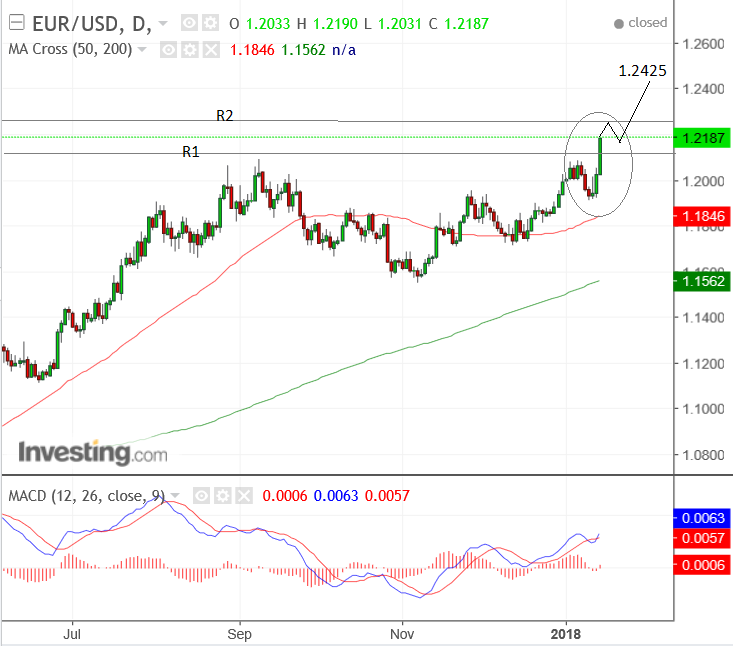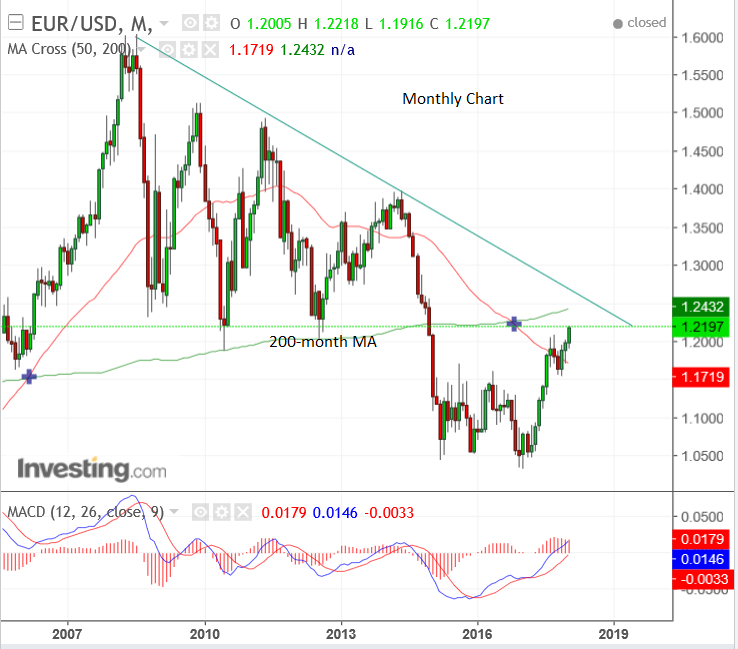Euro-to-Dollar Rate: Week Ahead Forecast

The EUR/USD exchange rate is in a strong uptrend sparked by greater optimism about the economic outlook from Europe's central bankers, we expect the trend higher to continue in the coming week.
The Euro-Dollar rate rose strongly last week after the minutes of the last European Central Bank (ECB) rate meeting showed policy-setters discussed bringing an end to its money-printing programme eyeing encouraging developments concerning Eurozone wages.
European policymakers saw "some comfort" in wage dynamics, according to the minutes, but low inflation remains a concern.
Significantly, they flag that a gradual shift in forward guidance could be forthcoming “in early 2018" if price pressures do pick up, which suggests rate setters have grown less dovish since their decision to cut bond purchases in October. Forward guidance refers to the choice of communication adopted by the ECB to ready markets for future changes in policy.
"These brief comments sent EUR/USD soaring 100 pips in a matter of hours and shifted the near term outlook for the euro. The single currency is poised for a move up to 1.21 versus the U.S. dollar and could extend those gains if Friday's U.S. economic reports fall short of expectations," says Kathy Lien, Director at BK Asset Management in New York.
The strength of the rally is highlighted in the circled portion of the chart below.

The pair has broken above the key 1.2094 September highs providing further evidence of the strength of the uptrend.
We expect the uptrend to continue until it reaches the next level of susbstantial resistance at 1.2224 where the R2 monthly pivot is situated.
Monthly pivots are obstacles to trends on charts as they often coincide with reversals or consolidations, as traders often target them as levels to trade against the dominant trend in an attempt to profit from the short-term volatility which oftens surrounds them.
So strong is the uptrend at the moment, however, that we do not expect a very large correction at R2, and expect the exchange rate to break higher relatively quickly.
Above 1.2250 we see a clear run higher to the next major resistance level at 1.2432 where the 200-month moving average (MA) is situated (see chart below).

Large moving averages act as dynamic support and resistance levels where prices often stall, pull-back or reverse entirely, thus there is a greater-than-average possibility that the exchnage rate could stop rising at the 200-month MA.
Get up to 5% more foreign exchange by using a specialist provider to get closer to the real market rate and avoid the gaping spreads charged by your bank when providing currency. Learn more here.
Data and Events for the Euro
The market expects positive data for the Euro and the consensus view is that the region is on a strong recovery track - a negative result, therefore, is more likely to cause volatility as it unexpected; for a higher result to cause volatility it will have to be much higher than expected.
The week kicks off with retail sales data for November, out on Monday, January 8, at 10.00 GMT, which is forecast to show a rise of 1.3% from -1.1% previously.
The unemployment rate is out on Tuesday, January 9 at 10.00 and is expected to show a basis point fall to 8.7% from 8.8%.
Industrial Production is out on Thursday at 10.00 and is expected to show a rise of 0.6% in November from 0.2% previously.
The minutes the ECB rate meeting will be out at 12.30 on Thursday and are likely to draw attention from investors.
The minutes will reveal the governing council's current thinking on monetary policy and when it is expecting to end QE.
QE is an elaborate form of money-printing used to alleviate crisis-hit economies, which is negative for a currency, so the date when the ECB finally expects to end it is likely to impact on the Euro, with the market currently expecting an end to QE in 2018.
Data and Events for the Dollar
Fiscal risks may permeate the market agenda in the coming week as the US government starts to run out of money again and its accumulated debt reaches precariously close to the last agreed debt-limit.
"Risks of a week-ending US government shutdown appear to be rising. A can-kick puts the next deadline dangerously close to the debt limit, which could increase dislocations in the bill market as last summer," says Canadian investment bank TD Securities.
The impact of rising concerns would be negative for the Dollar, especially with recent jitters over the sustainability of foreign demand for US debt.
Watch for, "An acrimonious split, especially among Republicans," says TD, as this would "create market uncertainty around the 2018 Trump agenda and the midterm elections."
New York Empire State Manufacturing is out at 13.30 GMT on Tuesday, December 16, and will be instructive in providing a leading indication of how conditions are evolving in January.
Current expectations are for no-change from the 18.0 result in December.
Philidelphia Fed Manufacturing for January, meanwhile, is out on Thursday at 13.30 and forecast to actually show a fall to 25.0 from 27.9 previously.
"The results of the New York Fed’s Empire index (Tuesday) and the Philadelphia Fed’s index (Thursday) will provide us with preliminary indications of the strength of the manufacturing sector in January," says Desjardin, Senior Economist, Hendrix Vachon.
On Wednesday evening there is commentary from Federal Reserve speakers, Mester, at 21.30 who is a hawkish voting member, and Kaplan at 20.15 who is not.
Also out on Wednesday is the Fed's Beige Book, which is an update on economic conditions throughout the US and is a useful gauge for assessing the Fed's outlook.
Get up to 5% more foreign exchange by using a specialist provider to get closer to the real market rate and avoid the gaping spreads charged by your bank when providing currency. Learn more here.










